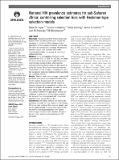| dc.contributor.author | Hogan, Daniel R | |
| dc.contributor.author | Salomon, Joshua A | |
| dc.contributor.author | Canning, David | |
| dc.contributor.author | Hammitt, James K | |
| dc.contributor.author | Zaslavsky, Alan M | |
| dc.contributor.author | Bärnighausen, Till | |
| dc.date.accessioned | 2013-04-25T14:46:20Z | |
| dc.date.issued | 2012 | |
| dc.identifier.citation | Hogan, Daniel R., Joshua A. Salomon, David Canning, James K. Hammitt, Alan M. Zaslavsky, and Till Bärnighausen. 2012. National HIV prevalence estimates for sub-Saharan Africa: Controlling selection bias with Heckman-type selection models. Sexually Transmitted Infections 88(Suppl 2): i17-i23. | en_US |
| dc.identifier.issn | 1368-4973 | en_US |
| dc.identifier.uri | http://nrs.harvard.edu/urn-3:HUL.InstRepos:10586352 | |
| dc.description.abstract | Objectives: Population-based HIV testing surveys have become central to deriving estimates of national HIV prevalence in sub-Saharan Africa. However, limited participation in these surveys can lead to selection bias. We control for selection bias in national HIV prevalence estimates using a novel approach, which unlike conventional imputation can account for selection on unobserved factors. Methods: For 12 Demographic and Health Surveys conducted from 2001 to 2009 (N=138 300), we predict HIV status among those missing a valid HIV test with Heckman-type selection models, which allow for correlation between infection status and participation in survey HIV testing. We compare these estimates with conventional ones and introduce a simulation procedure that incorporates regression model parameter uncertainty into confidence intervals. Results: Selection model point estimates of national HIV prevalence were greater than unadjusted estimates for 10 of 12 surveys for men and 11 of 12 surveys for women, and were also greater than the majority of estimates obtained from conventional imputation, with significantly higher HIV prevalence estimates for men in Cote d'Ivoire 2005, Mali 2006 and Zambia 2007. Accounting for selective non-participation yielded 95% confidence intervals around HIV prevalence estimates that are wider than those obtained with conventional imputation by an average factor of 4.5. Conclusions: Our analysis indicates that national HIV prevalence estimates for many countries in sub-Saharan African are more uncertain than previously thought, and may be underestimated in several cases, underscoring the need for increasing participation in HIV surveys. Heckman-type selection models should be included in the set of tools used for routine estimation of HIV prevalence. | en_US |
| dc.language.iso | en_US | en_US |
| dc.publisher | BMJ Publishing Group | en_US |
| dc.relation.isversionof | doi:10.1136/sextrans-2012-050636 | en_US |
| dc.relation.hasversion | http://www.ncbi.nlm.nih.gov/pmc/articles/PMC3512441/pdf/ | en_US |
| dash.license | LAA | |
| dc.subject | Africa | en_US |
| dc.subject | HIV | en_US |
| dc.subject | Surveillance | en_US |
| dc.subject | HIV Testing | en_US |
| dc.title | National HIV prevalence estimates for sub-Saharan Africa: Controlling selection bias with Heckman-type selection models | en_US |
| dc.type | Journal Article | en_US |
| dc.description.version | Version of Record | en_US |
| dc.relation.journal | Sexually Transmitted Infections | en_US |
| dash.depositing.author | Zaslavsky, Alan M | |
| dc.date.available | 2013-04-25T14:46:20Z | |
| dc.identifier.doi | 10.1136/sextrans-2012-050636 | * |
| dash.contributor.affiliated | Hogan, Daniel R | |
| dash.contributor.affiliated | Salomon, Joshua | |
| dash.contributor.affiliated | Hammitt, James | |
| dash.contributor.affiliated | Zaslavsky, Alan | |
| dash.contributor.affiliated | Canning, David | |
| dc.identifier.orcid | 0000-0003-3929-5515 | |
| dc.identifier.orcid | 0000-0003-4041-1229 | |


